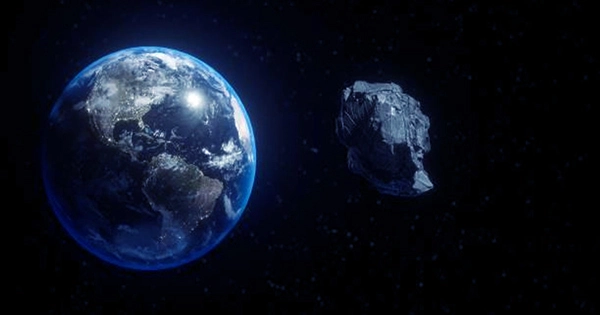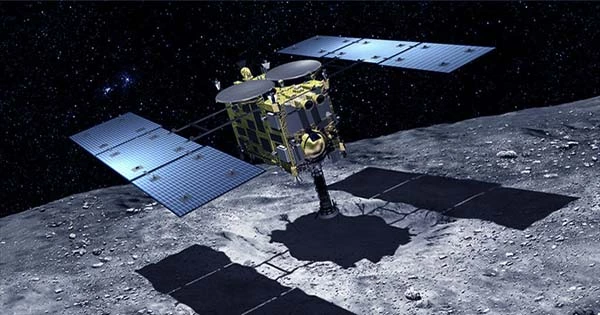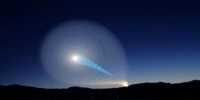Amino acids and the existence of water have been discovered in the sample retrieved from the C-type asteroid Ryugu. The discovery supports the theory that the building elements for life were present in the material that created the Solar System and were brought to Earth on an asteroid of this sort. The Hayabusa mission obtained the first asteroid sample to be returned to Earth in 2005. Itokawa, the target in that case, was classified as an S-type due to its high silicon content. S-types are the most prevalent in the inner Solar System, making them an accessible target.
Hayabusa2 was a more ambitious follow-up mission, aiming to capture an asteroid assumed to have migrated in from beyond the Solar System and retain a more complete record of the nebula from which the Sun and planets originated. Some of what was discovered is revealed in a report published today in the Proceedings of the Japan Academy, while the most crucial aspect of the revelation — the existence of 20 amino acids – was leaked to the Japan Times a few days ago. A third paper, published three hours later in Science, comes to the same result.

Cutting up the Hayabusa2 revealed features indicative of a freeze-thaw cycle even before chemical investigation began. The materials are largely fine-grained hydrous silicates, which we name clay on Earth, with coarser-grained deposits strewn around. Hydrous silicate is formed when dry silicates react with liquid water. Following evidence, it was discovered that water existed within a few million years of the Solar System’s birth. Ryugu’s isotopes are consistent with an object that arose from a protosolar nebula early in the Solar System’s existence and is located distant from the Sun.
The scientists believe that because Ryugu was too distant from the Sun to melt from external heat, radioactive elements within it must have given the energy to melt the ice. Most of its more radioactive isotopes decayed within a few million years, limiting heat output and forcing the ice to refreeze. Ryugu, on the other hand, is barely 435 meters (1,400 feet) broad, making it too tiny for radioactive decay to have melted liquid water. The heat created by such a large object would swiftly escape into space. As a result, the authors believe Ryugu was previously part of a much larger object, with a diameter of many tens of kilometers at the very least.
A collision tore its ancestor apart at some time, and Ryugu was one of the parts. Ryugu would have been more of a comet than an asteroid at first. It was drawn into the inner Solar System by gravitational interactions with one or more planets, where sunlight converted its ice to water vapor, leaving it barren and porous. According to previous modeling, jets of gas ejected during this process boosted Ryugu’s rate of spin and gave it its characteristic form. It’s conceivable that stuff from deep below was raised to the surface so Hayabusa2 could capture it throughout the process.
Hayabusa2 took samples from two separate locations on Ryugu, which proved to be a prudent option since the variances in composition reveal a tale. The material from touchdown site 1 (TD1) is most likely a combination transported to the surface by a water vapor jet from various sections of the interior and redeposited there. TD2 is more uniform, which is likely due to the fact that it was not churned up as much and was only revealed upon an impact. Amino acids have been discovered in carbonaceous chondrite meteorites, raising the possibility that they were present on the C-type asteroids that these meteorites came from.
However, because meteorites are by definition exposed to the Earth’s atmosphere, only a sample taken directly from an item like Ryugu could rule out the idea that the biological material in a meteorite was contaminated by Earth. Hayabusa2 has answered that issue, making it more plausible that asteroids provided the resources needed to synthesize DNA and RNA, which can be catalyzed by nucleotides produced from amino acids, according to recent findings. The fact that it was originally so water-rich supports the theory that asteroids like this refilled the Earth’s supply after the initial water melted away during the planet’s very hot period.
The Ryugu samples and the Ivuna meteorite, which landed over Tanzania, have a lot in common, according to the Science report. Ivuna belongs to the CI group of meteorites, which is one of the rarest. My initial thought was to “oh my god! This is simply incredible “In response to the Science publication, Curtin University’s Dr Gretchen Benedix commented. “We’ve gotten other samples returned from planetary bodies previously, but never the Solar System’s most primordial stuff.”
Flinders University’s Dr Alice Gorman, who, like Benedix, was not a co-author on either publication, said. “There are just a few dozen meteorites like Ivuna and Ryugu among the world’s roughly 50,000 known meteorites. They’re water-rich, and collisions from asteroids and meteorites similar to them may have brought water to Earth and the Moon early in the solar system’s history. The Earth examples, on the other hand, are vulnerable. Weathering has tainted them, causing them to absorb moisture and other substances. Because the Ryugu sample is pure, it can reveal a great deal more.”
“Surprisingly, Ryugu’s composition is remarkably similar to that of the Sun’s outer layer,” Gorman added. “This suggests that its parent body originated about the same time as the solar system’s origins, around 4.6 billion years ago.” It’s a fascinating look into a time when the planets were just starting to form and the Sun was still a baby.”
















